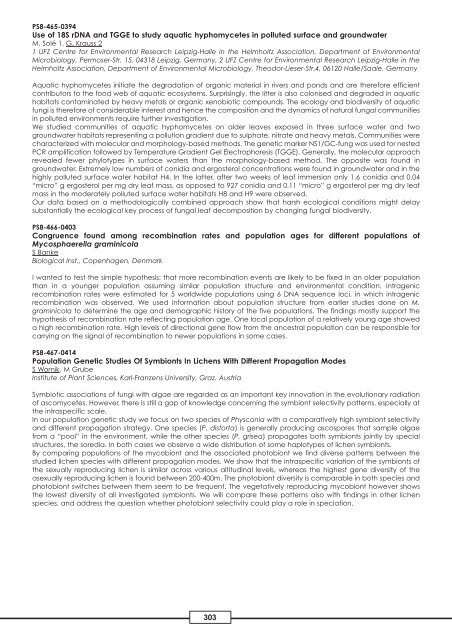Handbook Part 2 - International Mycological Association
Handbook Part 2 - International Mycological Association
Handbook Part 2 - International Mycological Association
You also want an ePaper? Increase the reach of your titles
YUMPU automatically turns print PDFs into web optimized ePapers that Google loves.
PS8-465-0394<br />
Use of 18S rDNA and TGGE to study aquatic hyphomycetes in polluted surface and groundwater<br />
M. Solé 1, G. Krauss 2<br />
1 UFZ Centre for Environmental Research Leipzig-Halle in the Helmholtz <strong>Association</strong>, Department of Environmental<br />
Microbiology, Permoser-Str. 15, 04318 Leipzig, Germany, 2 UFZ Centre for Environmental Research Leipzig-Halle in the<br />
Helmholtz <strong>Association</strong>, Department of Environmental Microbiology, Theodor-Lieser-Str.4, 06120 Halle/Saale, Germany<br />
Aquatic hyphomycetes initiate the degradation of organic material in rivers and ponds and are therefore efficient<br />
contributors to the food web of aquatic ecosystems. Surprisingly, the litter is also colonised and degraded in aquatic<br />
habitats contaminated by heavy metals or organic xenobiotic compounds. The ecology and biodiversity of aquatic<br />
fungi is therefore of considerable interest and hence the composition and the dynamics of natural fungal communities<br />
in polluted environments require further investigation.<br />
We studied communities of aquatic hyphomycetes on alder leaves exposed in three surface water and two<br />
groundwater habitats representing a pollution gradient due to sulphate, nitrate and heavy metals. Communities were<br />
characterized with molecular and morphology-based methods. The genetic marker NS1/GC-fung was used for nested<br />
PCR amplification followed by Temperature Gradient Gel Electrophoresis (TGGE). Generally, the molecular approach<br />
revealed fewer phylotypes in surface waters than the morphology-based method. The opposite was found in<br />
groundwater. Extremely low numbers of conidia and ergosterol concentrations were found in groundwater and in the<br />
highly polluted surface water habitat H4. In the latter, after two weeks of leaf immersion only 1.6 conidia and 0.04<br />
“micro” g ergosterol per mg dry leaf mass, as opposed to 927 conidia and 0.11 “micro” g ergosterol per mg dry leaf<br />
mass in the moderately polluted surface water habitats H8 and H9 were observed.<br />
Our data based on a methodologically combined approach show that harsh ecological conditions might delay<br />
substantially the ecological key process of fungal leaf decomposition by changing fungal biodiversity.<br />
PS8-466-0403<br />
Congruence found among recombination rates and population ages for different populations of<br />
Mycosphaerella graminicola<br />
S Banke<br />
Biological Inst., Copenhagen, Denmark<br />
I wanted to test the simple hypothesis: that more recombination events are likely to be fixed in an older population<br />
than in a younger population assuming similar population structure and environmental condition. Intragenic<br />
recombination rates were estimated for 5 worldwide populations using 6 DNA sequence loci, in which intragenic<br />
recombination was observed. We used information about population structure from earlier studies done on M.<br />
graminicola to determine the age and demographic history of the five populations. The findings mostly support the<br />
hypothesis of recombination rate reflecting population age. One local population of a relatively young age showed<br />
a high recombination rate. High levels of directional gene flow from the ancestral population can be responsible for<br />
carrying on the signal of recombination to newer populations in some cases.<br />
PS8-467-0414<br />
Population Genetic Studies Of Symbionts In Lichens With Different Propagation Modes<br />
S Wornik, M Grube<br />
Institute of Plant Sciences, Karl-Franzens University, Graz, Austria<br />
Symbiotic associations of fungi with algae are regarded as an important key innovation in the evolutionary radiation<br />
of ascomycetes. However, there is still a gap of knowledge concerning the symbiont selectivity patterns, especially at<br />
the intraspecific scale.<br />
In our population genetic study we focus on two species of Physconia with a comparatively high symbiont selectivity<br />
and different propagation strategy. One species (P. distorta) is generally producing ascospores that sample algae<br />
from a “pool” in the environment, while the other species (P. grisea) propagates both symbionts jointly by special<br />
structures, the soredia. In both cases we observe a wide distribution of some haplotypes of lichen symbionts.<br />
By comparing populations of the mycobiont and the associated photobiont we find diverse patterns between the<br />
studied lichen species with different propagation modes. We show that the intraspecific variation of the symbionts of<br />
the sexually reproducing lichen is similar across various altitudinal levels, whereas the highest gene diversity of the<br />
asexually reproducing lichen is found between 200-400m. The photobiont diversity is comparable in both species and<br />
photobiont switches between them seem to be frequent. The vegetatively reproducing mycobiont however shows<br />
the lowest diversity of all investigated symbionts. We will compare these patterns also with findings in other lichen<br />
species, and address the question whether photobiont selectivity could play a role in speciation.<br />
303









